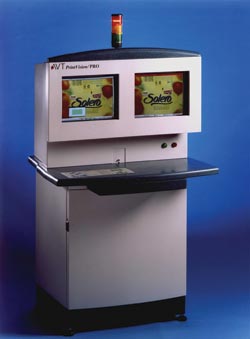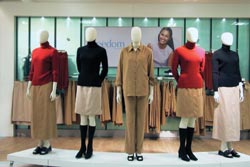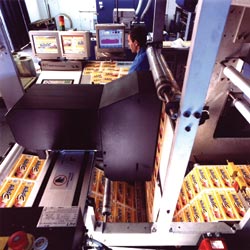Cameras offer advantages for color measurement, but their application requires knowledge and attention to detail.
Dr. Christine Connolly, Contributing Editor
Video cameras find use in many
automatic inspection applications, from checking the construction of automobiles
to scanning microscope specimens for cancerous cells. Often it is important to inspect
color as well as other attributes of a product; for example, the color of a car,
of printed packaging material, of wallpaper and of foodstuffs.
However, it is astonishingly difficult for video
cameras to measure color with a degree of accuracy anywhere approaching that of
the human eye. Successful measurement requires simultaneous control over multiple
parameters, including lighting, settings and temperature.
To understand the design and operation
of color video cameras, it helps to recognize their history. They were developed
for the television industry, where their purpose was to record a scene so that its
display would be acceptable to viewers.
Because the display phosphors of a
television screen emit light with intensity proportional to the square of the signal,
engineers built gamma-correction amplifiers into television cameras to ensure that
their signal was the intensity’s square root. In this way, the complete system
is linear and reproduces balanced colored scenes. Video color measurement, however,
takes data directly from the camera, meaning that signals are not proportional to
light intensity.

To use a camera for color measurement, it is necessary to turn off the automatic gamma
correction, aperture control, balance and gain, and to remove any temperature variations.
Courtesy of Advanced Vision Technology Ltd.
Cameras have a lot of sophisticated
circuitry built in to make them easier to operate in changing lighting conditions.
They are designed to open their aperture or boost their electronic gain in dull
light and to boost the blue signal if the lighting is yellow. This is convenient
when photographing outdoor scenes, but it adds a set of uncontrolled variables to
the camera response and makes the measurement of color less accurate.
Measuring color
One of the first things to do before using a camera
for color measurement is to turn off the gamma correction, or set it to unity gamma
to establish an accurate, preferably linear, relationship between the intensity
of incident light and signal strength in the red, green and blue channels. It also
is important that channel signals bear the correct relationship to each other, proportional
to the ratio of light intensity in each of the wavebands. This will not be the case
if the camera has its automatic balance activated. Aperture control, too, must be
turned off.
In practice, this requires a professional-grade
camera, because lower-end cameras cannot disable gamma, balance or automatic gain
control.
Temporal repeatability is another important
consideration. Video cameras are sensitive to temperature, which means that output
signals — and color measurements — can change significantly as the devices
warm up during the first half-hour of operation. Cameras also are affected by ambient
temperature. To achieve temporal repeatability, it is necessary to control or compensate
for the camera’s temperature dependence and to eliminate any temperature variations.
Video cameras are well-suited for measuring
color in that they are noncontact instruments and can be used online without disrupting
production. When monitoring printed webs, for example, flash illumination or fast
shutters would freeze the motion, and the camera’s field of view would cover
perhaps the central third of the web. Video systems are comparatively fast, measuring
several colors in a web in one second or so. In contrast, a spectrophotometer or
colorimeter would require taking a sample from the production line and positioning
the instrument in contact with each area to be measured. Taking a sample may mean
stopping production while the color is measured — an inefficient procedure
— or it may mean waiting until the end of the printed reel, by which time
many meters of inaccurately colored material will have been produced.

Clothing manufacturers
use color inspection instruments during production to eliminate mismatched and inconsistent
colors. Shoppers benefit from the opportunity to purchase coordinated outfits.
There is a delay inherent with contact
instruments. They report quality historically, but a camera produces real-time measurements,
making it possible to correct faults.
For example, the Registron Q100M defect-detection
system from Bobst Group SA in Lausanne, Switzerland, can inspect board webs up to
1300 mm wide, operating at speeds of up to 300 m/min. It can detect printing faults
such as misregistration and streaks that appear on a color monitor. The system performs
a real-time comparison of a previously stored image with the live running image,
and any abnormalities, such as splashes or streaks, are highlighted on the monitor.
Advanced Vision Technology Ltd., headquartered
in Hod Hasharon, Israel, produces the PrintVision/ 9000NT, a video-based inspection
system that allows the operator to specify independent thresholds for color-specific
printing defects, such as variation and registration. The company says that its
system has enabled many web operators to increase press speeds by as much as 50
percent.

Unlike conventional instruments that require contact measurement,
such as colorimeters and spectrophotometers, video cameras can produce real-time
color measurements. Courtesy of Advanced Vision Technology Ltd.
To comply with CIE standards and improve
agreement with handheld instruments, it is advisable to use a xenon light to approximate
standard illuminants and to set up the lighting and the camera in a standard geometry,
0/45° or diffuse/8°. With a wide-angle lens, it is not possible to achieve
this for the whole field of view, but it is good practice to do it within the center.
Make sure that the relative positions of the camera, the light source and the inspected
surface remain fixed. The lighting must be constant in intensity and in spectral
composition.
It is tempting to measure the color
of individual pixels, but this leads to inaccuracy for three reasons:
• If the camera is a single-chip
device, red, green and blue signals are taken from different spatial positions on
the object. It is best to use a three-chip camera.
• Electronic noise causes digitization
errors, which have dramatically adverse effects on color measurement. A 1-bit error
in an 8-bit digitized value is equivalent to a worst-case color difference of 10
CIELAB standard units.
• A pixel may straddle two colors
in the object, so it is best to measure the color of a collection of pixels taken
from a uniformly colored, uniformly lit area of the object and well away from edges
or color changes.
My own measurements with a well-controlled,
linearized and calibrated camera in a controlled lighting environment showed that
the camera’s short-term repeatability on the 12 standard tiles was 0.3 CIELAB
units, which compares favorably with that of handheld instruments.
Because of the spectral response of
their filters, cameras have a different color gamut from colorimeters. All colors
that fall within the common gamut can be rigorously converted from red-green-blue
values to tristimulus X-Y-Z values using a matrix transformation. A highly saturated
color beyond the camera’s spectral range, however, would register as a negative
reading in one of the channels. Because red-green-blue signals cannot fall below
zero, such colors would be measured incorrectly.
A camera recently developed by Delta
in Lyngby, Denmark, uses colorimeterlike filters and thus extends video cameras’
applicable range. The ICAM produces CIE-standard measurements. However, it, too,
will measure color repeatably and accurately only if all other factors are tightly
controlled.
It is important to use standard lighting
and geometry and to control the intensity of lighting. If possible, establish a
linear relationship between light intensity and signal size. If that can’t
be done, characterize the response curve to establish a known relationship.
Next, convert camera signals to a uniform
and internationally recognized color space. This aids communication with users of
conventional color measuring instruments and enables inspection of products using
a simple threshold.
When all variables are under control,
video cameras can measure color with a repeatability and stability comparable to
a colorimeter. They have the advantages of automatic real-time operation and the
ability to measure many regions of the product simultaneously.
Converting the Eye into Numbers
Color measurement is not a simple physical process because color is a feature of human perception, not a purely objective phenomenon. It is the eye of the customer that decides if
a product is acceptable.
Spectral curves of the three broadband
light sensors in the human eye are different from those of the red, green and blue
filters in a camera. Although the basic mechanism of color sensing is the same,
when describing a color we do not say that it comprises “a large red and green
signal and a little blue.” We say “bright yellow.” The signals
from our receptors go through some complex processing in the brain before they become
available to us on a conscious level. For this reason, the raw red-green-blue values
from a camera are of little use in visualizing color. The eye’s perception,
therefore, must be transformed into a quantifiable quality before metrics can be
applied.
The hue-saturation-value color space,
for instance, is a simple mathematical transformation in which the color space is
regarded as a cube, where value is a measure of distance along the locus of white,
gray and black, which traverses the cube’s diagonal from (0, 0, 0) to (255,
255, 255). Hue defines an angle in the plane normal to the gray axis, and saturation
is a measure of distance from the gray axis. This color space works well because
it furnishes a description of color that is easy to visualize. But it falls short
in that it is a nonuniform color space: In some areas, small changes in hue, saturation
or value represent a huge perceptual color difference, while in other regions, large
changes in the metrics correspond to imperceptible color differences.
The 1976 CIE L*a*b* equation, also
known as CIELAB, provides a means of transforming three broadband signals into L*,
a* and b* axes that form a perceptually uniform color space. The Euclidian distance
between two points in L*a*b* space gives a single-figure measure of the perceptual
color difference, with one CIELAB unit generally taken to be the smallest perceptual
color difference.
Conventional Color Measurement
Colorimeters and spectrophotometers have been around since the mid-20th century. Colorimeters
measure color differences between a sample and a target color using three broadband
filters to produce CIE tristimulus X-Y-Z values, which an onboard processor converts
to L*a*b* values and then to a single figure that represents the color difference.
Using a simple numerical threshold, colorimeters can sort samples for visual acceptability.
Spectrophotometers measure the full
reflectance curve of a surface, taking measurements at perhaps 30 narrowband wavelengths
across the visible region. They can measure absolute color or color differences
under a variety of light sources.
Both are available in two geometric
forms:
• The 0/45° instruments
illuminate the surface at 0° to the normal and sense the reflected light at
45° to the normal.
• The diffuse/8° models
illuminate the surface with light reflected at all angles from inside a white-coated
sphere and sense the light reflected at 8° to the normal.
The French Commission International
de L’Eclairage specifies various illuminants for color measurement: Illuminant
A corresponds to tungsten light, and illuminants C and D to daylight. Most spectrophotometers,
colorimeters and camera-based inspection systems use a pulse of xenon light to illuminate
the surface, and this closely approximates illuminant D.
Handheld spectrophotometers and colorimeters
deliver repeatability within 0.05 CIELAB units rms. That figure is obtained by taking
10 measurements, in rapid succession, of exactly the same position on a flat, even
white tile. In practice, the repeatability range is much larger if the instrument
moves slightly over the tile surface, if the measurements are taken over a longer
period of time, if some other color tile is used, or if the surface is textured,
as in a textile fabric or a wallpaper sample.
My own experiments show that the repeatability
of a handheld instrument when measuring the color of a standard set of 12 tiles
is typically 0.5 CIELAB units (maximum) in 10 rapidly repeated readings.
The spec sheets for these instruments
typically give the inter-instrument agreement as 0.25 CIELAB units. Again, this
assumes that the two instruments have been calibrated on the same standard and are
measuring precisely the same position on the surface of the same standard. It is
more difficult to get agreement between two instruments if they are on different
sites, each using its own calibration standard. In a survey of color measurement
practice, the National Physical Laboratory in Teddington, UK, found that experienced
users were typically inaccurate by three CIELAB units.